Kia Picanto review and buyer's guide
In these financially challenging times, the Picanto makes buying a second-hand city car economically irrational. Here’s how you can do cost-cutting without skimping on functionality or quality. But what’s the catch?
The Kia Picanto is a city car that makes light work of daily commuter city traffic and offers an affordable money-smart solution to the basic transport needs of a typical small family.
The term ‘cheap and cheerful’ is often misused with a negative connotation, despite the actual wording implying otherwise, and the Kia Picanto is a stark example of the true meaning of the expression. It’s nice to drive, it’s affordable and it’s practical without the waste of bigger, more demanding vehicles that cost thousands more.
Having said that, SUVs are fine, they are perfectly allowed and they do serve a genuine purpose. It’s also okay to simply want one. Anybody with a bulging disc or recovering from a torn ACL appreciates sliding across into an SUV more than climbing down into a notionally small car.
But if you are able-bodied, everything works fine, but money is tight - something thousands of people can attest to these days - it’s good to have a more affordable alternative to the medium SUV. Even the sales data suggests small cars might be having a comeback. Kind of.
Kia Picanto sales in 2023 improved 48 per cent over 2022, sales for ‘Light cars over $30K’ were 20 per cent up in 2023 over 2022, and in the first half of 2024 they’re up 24 per cent, as is the Toyota Yaris which has increased 44 per cent thus far. Overall, small cars are on a very gradual decline in favour of notionally ‘small’ SUVs, but the misunderstanding there is that the ‘SUV’ offers you more functionality than the small car they’re generally based on.
Australia’s fertility rate in 2023 was at its second-lowest since before the second world war, (the lowest was in 2020), which means fewer kids to replace their parents, smaller families and a reduced need to buy that small or medium SUV into the future.
In hard economic times the best way to fight depreciation on cars is to pay as little for the vehicle up-front when you purchase it. Small cars, or ‘micro cars’ as the car industry categorises Picanto as, are a great way to save money. Picanto is under $30,000, the Kia Seltos is under $45,000. The now-defunct Kia Rio was another example of small car besting SUV in terms of cost.
All these tiny cars offer 5 seats, although you’ll be hard-pressed squeezing them in - well, you won’t be hard-pressed, they will be. The point is, the amount of people they can potentially carry is virtually the same (but yes, acknowledging the compromise in legroom and headroom, obviously), and they all have luggage space for a few bags, maybe one big suitcase. And when nobody’s in your Picanto but you, clearly you can use the seats and the footwells, front and rear, in conjunction with the boot.
As a multi-tool for the general household running around, the Kia Picanto gets a lot done for under $30,000. And you will use every single inch of this little city machine to its maximum potential.
FEATURES & PRICING
There are just two model grades of Kia Picanto, which is such a saving of your time, you’ll be able to digest the entire array of features and cost without having to write anything down.
Both versions, the Picanto ‘Sport’ and ‘GT-Line’ are available with either a 4-speed manual or 5-speed automatic transmission, albeit with only one engine nowadays. (They dropped the spicy turbocharged 1-litre 3-cylinder engine at the end of 2023 - shamefully.) The engine you do get is a 1.2-litre 4-cylinder petrol engine that is naturally aspirated (no turbo), and we’ll get to the technical stuff down below in the ‘engine’ section.
The Picanto ‘Sport’ is $17,900 for the manual, or add $1600 for the automatic version at just $19,500. If you add driveway/on-road costs (which vary state to state, obviously) you’re looking at about $23,000 all up.
Do the same with the GT-Line and it’s more like $23,500 driveaway for the manual or $25,000 driveaway for the auto.
You can click here to download the Kia Picanto spec sheet >> to check for particular features, but here is a summary of the key equipment:
Picanto Sport gets:
14-inch alloy wheels (space-saver temporary spare wheel)
Collision avoidance: Blindspot collision avoidance, rear cross-traffic avoidance, safe exit warning, lane keeping & following, manual speed limiter, rear occupant alert (basic dash icon illumination), driver attention warning, lead vehicle departure alert.
Reverse parking sensors, rearview camera with dynamic parking guidelines, proximity smart key remote
Dusk-sensing auto headlights (halogen projection), halogen daytime running lights, rear foglight, LED rear parker/position light
8-inch LCD infotainment touchscreen, wireless Apple Carplay & Android Auto, 6-speaker (4 primary, 2 tweeter) stereo
3 x top tether anchor points, 2 x ISOFix anchor points (outboard), 60:40 folding rear seatbacks
Cloth seat trim, 4-way manual seat-adjustment, manual air conditioning
Basic cruise control, powered auto-folding door mirrors
1 x 12-volt power outlet, 1 x USB-A, 1 x USB-C charging port
Picanto GT-Line adds:
LED headlights, taillights & DRLs
15-inch alloys (space-saver spare)
Front parking sensors
Centre console storage with rear stowage cubby
‘Premium’ flat-bottom steering wheel & gearshifter, alloys sports pedals
Heated door mirrors, adjustable front seatbelt height, 6-way manually adjusted front seats
Premium cloth seats
FUNCTIONALITY
The boot of a Kia Picanto is modest, but only because of its advantageously and equally modest exterior dimensions. The fact it’s 28 per cent shorter and 19 percent narrower than a Toyota RAV4 makes it that much easier to park.
Open the manual hatch and you’ve got 255 litres of luggage space to work with, and to be fair, that’s about as much space left behind most 7-seaters when they have row 3 seats engaged. But you still have the rear seat footwells, the front footwell and the backseat itself to fully utilise for the weekly shopping run.
The rear seats split-fold in a typical 60:40 fashion favouring the 60 per cent side on the driver’s left-hand kerbside, which means when you have a child restraint in the back seat, you either have to make the bulky item fit lengthways on top of the collapsed 40-section of the seatback. Or you swap the restraint to the right-hand side, drop the 60-portion seatback, and slide the front-passenger seat forward potentially.
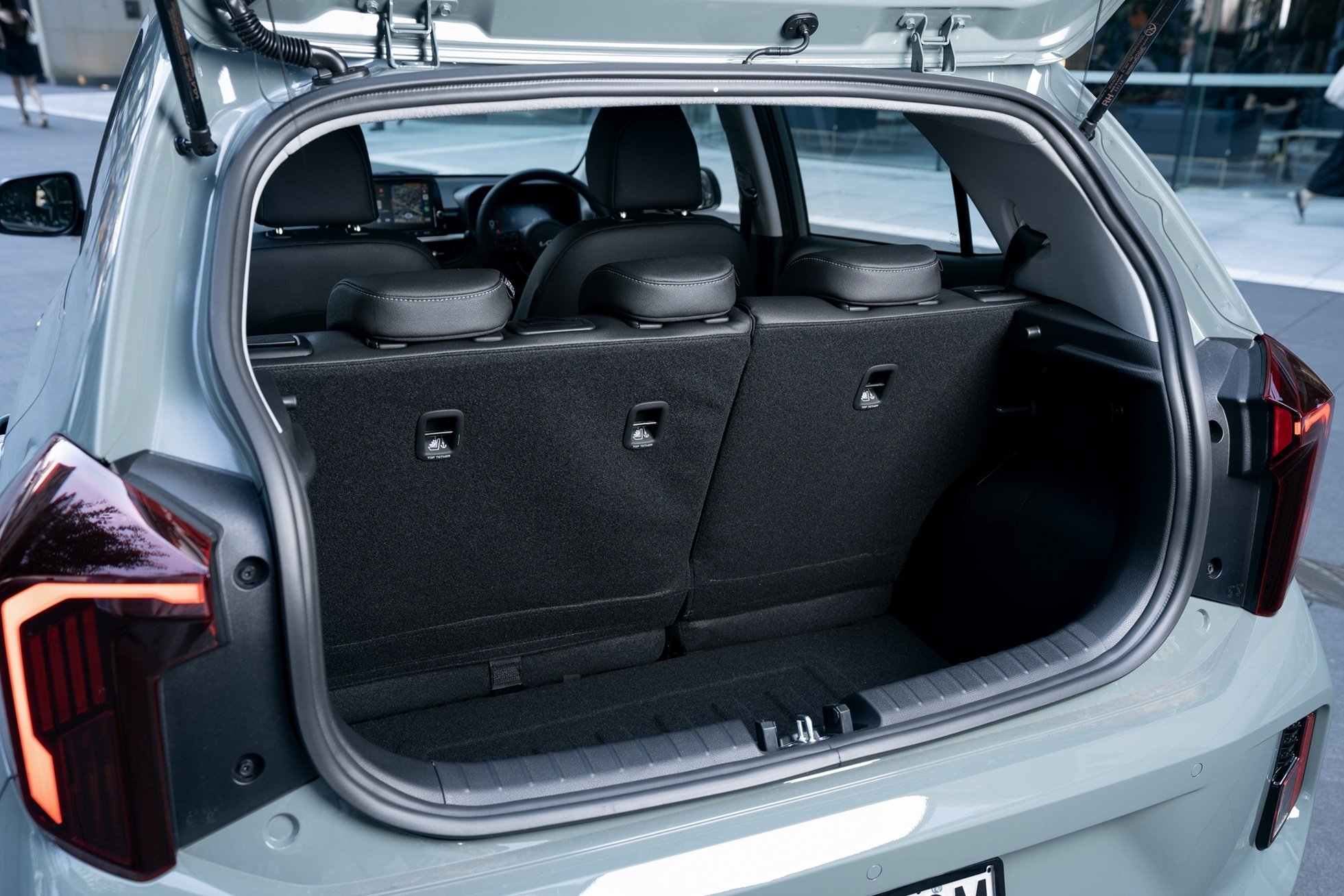
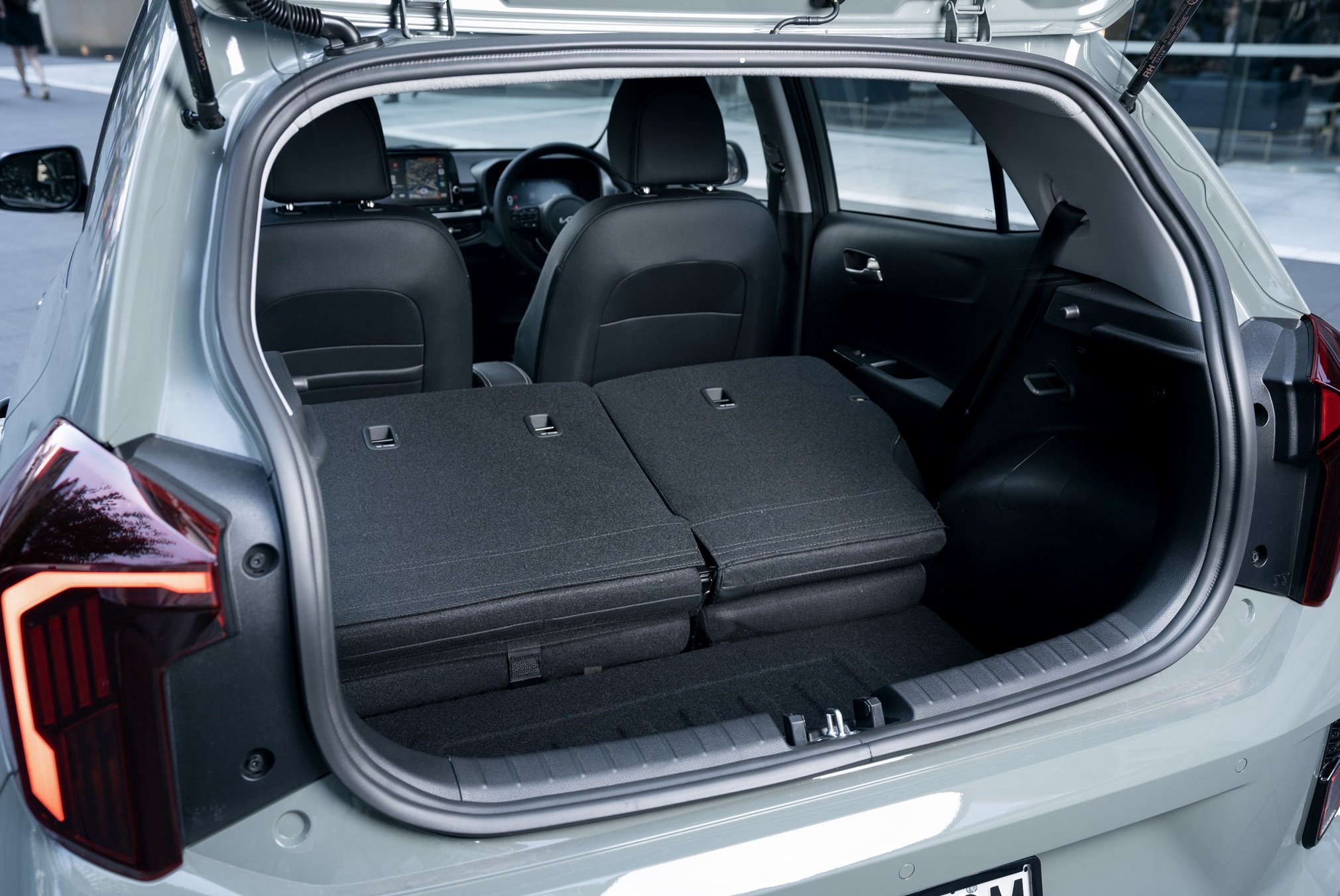
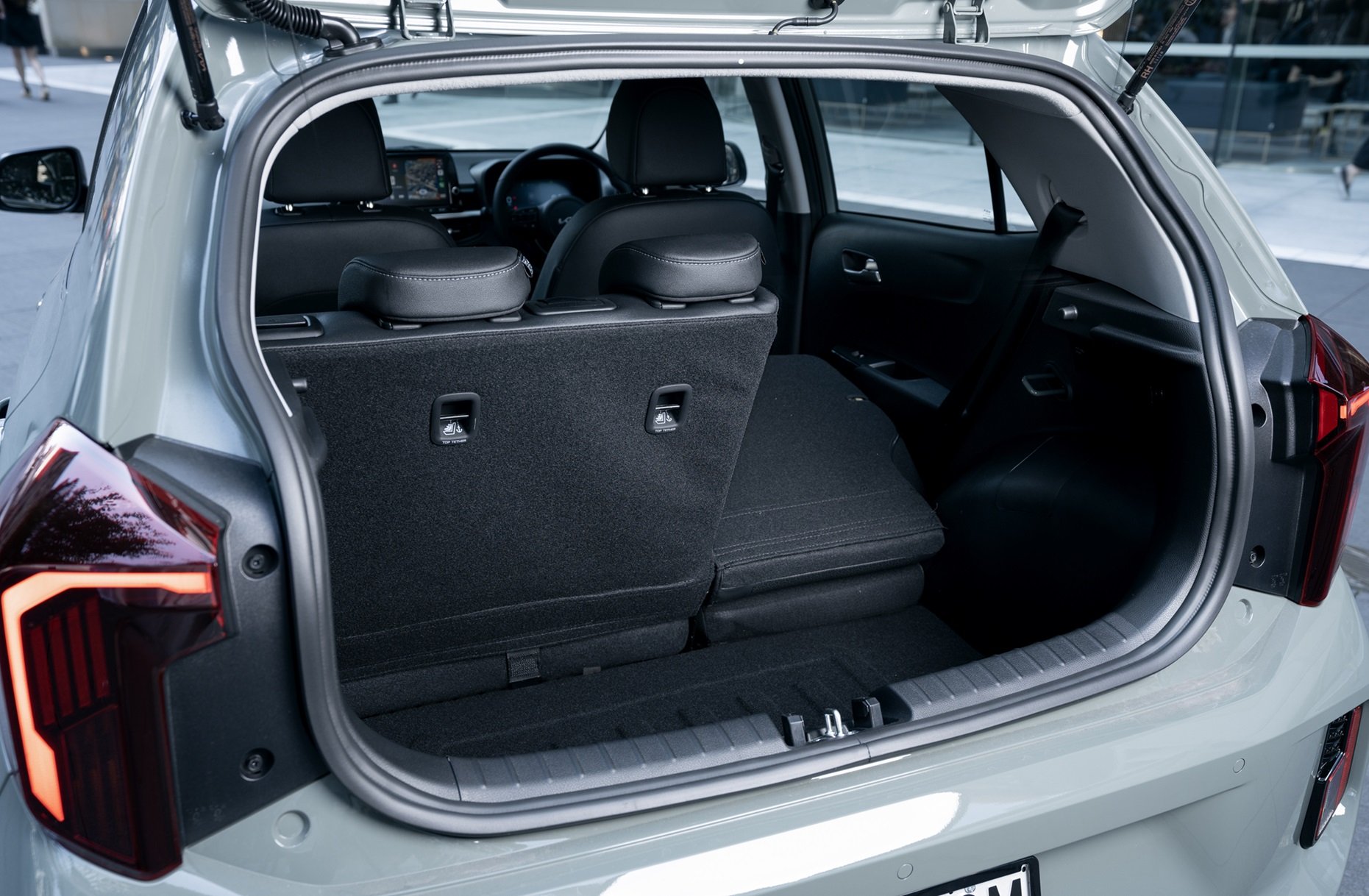
It’s very easy to look at the outright volume number and determine Picanto is simply too small or that there are better, more spacious affordable vehicles you could choose from - and that’s partly true. But how does its boot compare to similar vehicles like the Toyota Yaris, Mazda 2 and the Hyundai Venue, for example?
The key difference between something like a Picanto, and a small-to-medium SUV in regards to the luggage space in the boot, is in the latter, you can do kids and their restraints at the same time as fairly big and kind of bulky items. Whereas in a Picanto it’s more or less one or the other: seats up for Kid Mode, or seats down for Mini-Mini Van Mode.
If you don’t mind putting in that little bit of extra effort removing the child restraints in order to drop the seats, because there’s a new TV or some moving boxes or some flatpack furniture to convey, then Picanto GT just did the same two tasks for about $14,000 less than an entry-level Kia Sportage, Mazda CX-5, Hyundai Tucson, Mitsubishi Outlander or Subaru Forester.
And it’ll be cheaper to run, insure, service and a third less in on-road costs.
If you are feeling the pressure of the cost-of-living so-called crisis, then the Picanto is a legitimate solution.
INTERIOR
There’s not a great deal to rave about in the Picanto’s interior, but it is functional in a basic kind of way, and that’s the priority here. Does that mean the interior is entirely bland? Not necessarily, but there’s plenty of plastic trim and the cloth seats are durable and comfortable enough.
There’s no denying the Mazda 2’s interior is a bit nicer, but at least the Picanto has a centre console both for minimalistic storage but also for the simple task of supporting the resting demands of your left elbow. There’s no centre console in a Mazda 2.
There are no rear air vents, but the advantage of having such a small cabin is the heating and cooling air of the HVAC system is quite capable of warming or chilling without the need for rear ducts.
What’s refreshing about the Picanto’s interior is that, compared with the dashboard and steering wheel layouts of many more stylish and upper-echelon SUVs asking significantly more money, the buttons and core features you need to engage are easy to find, in a logical place, front-and-centre. They’re positioned in this way because they have to be, because there’s literally no room to waste and designers are forced to be efficient, and simplify - not show-off and indulge.
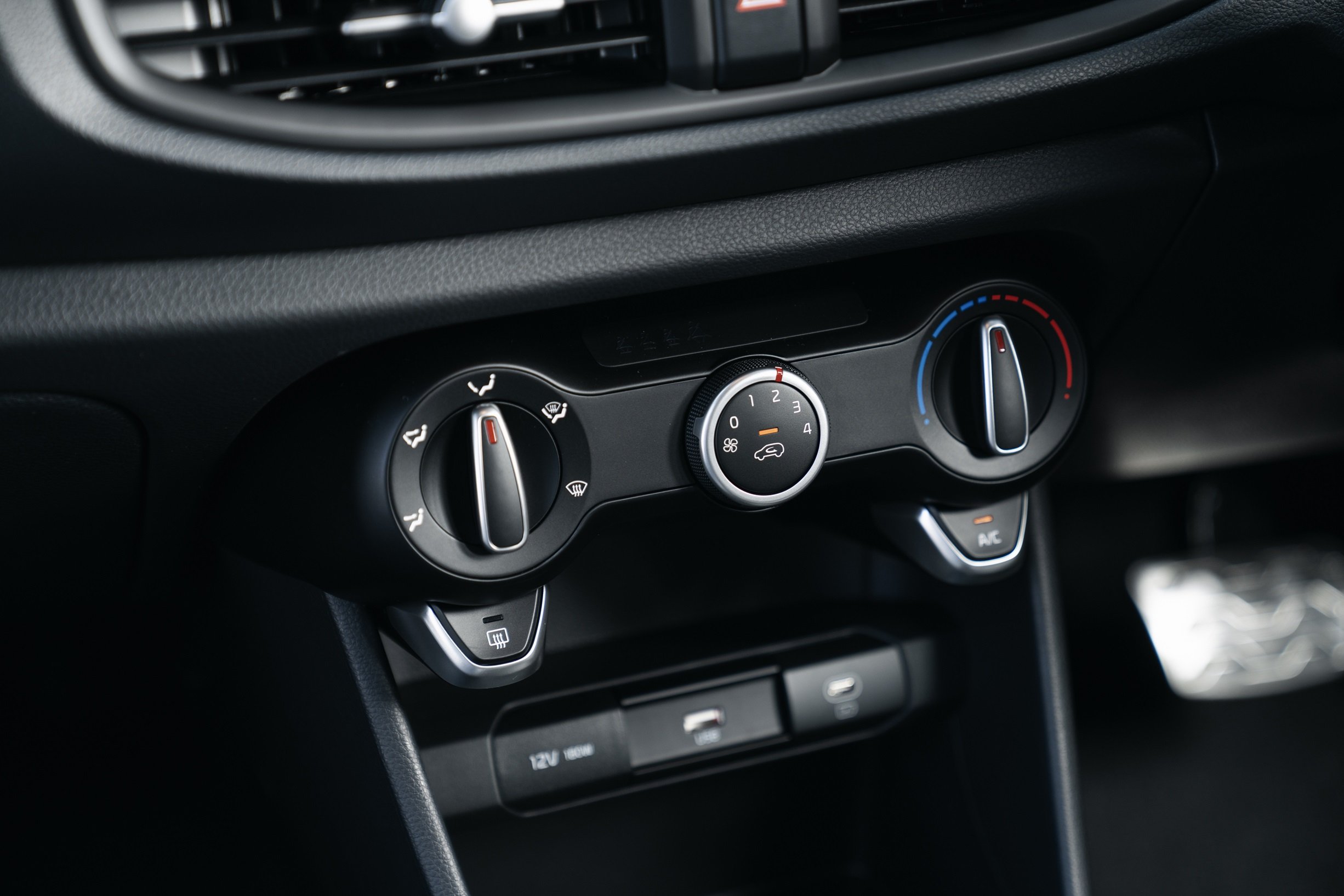
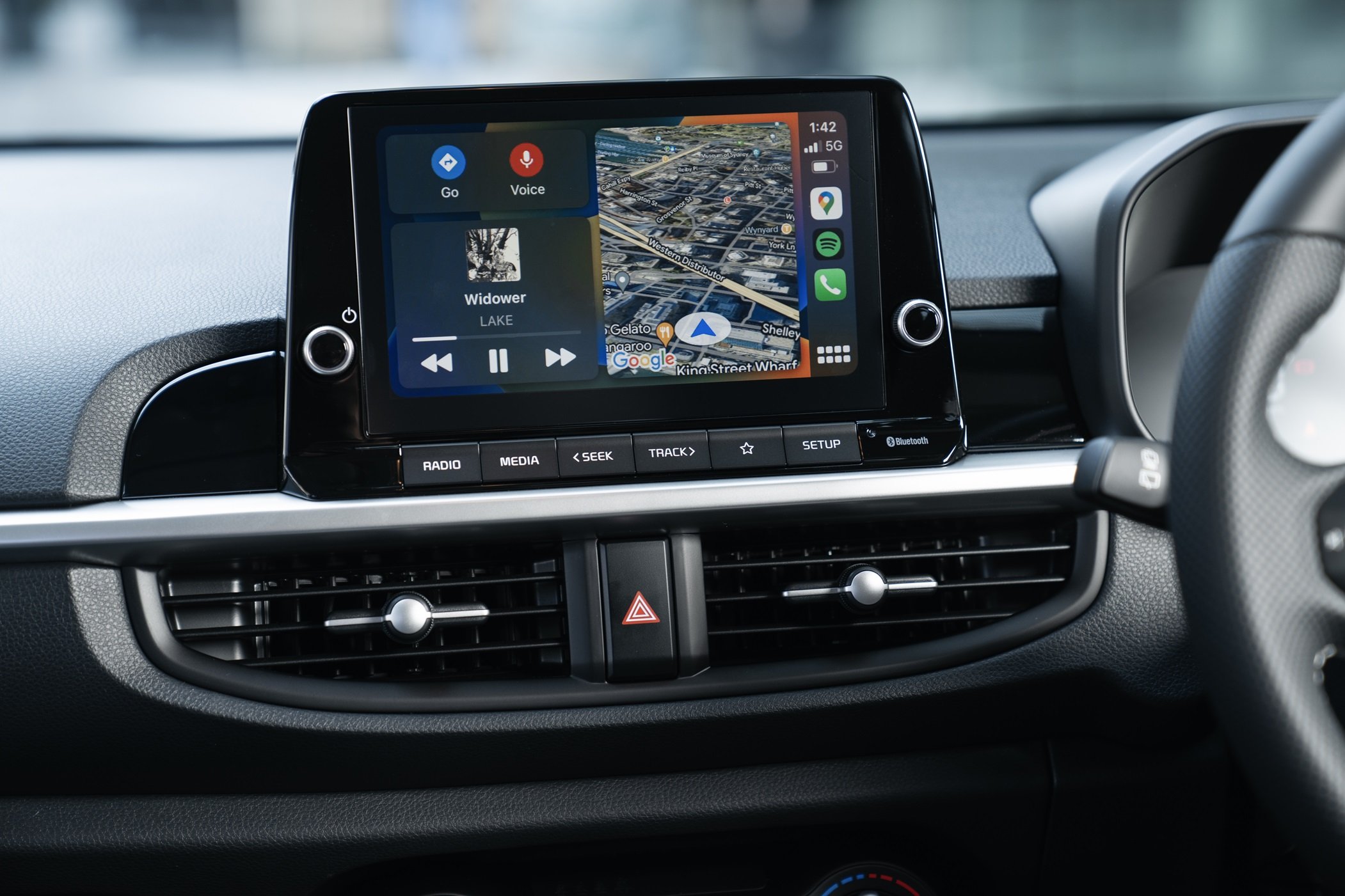
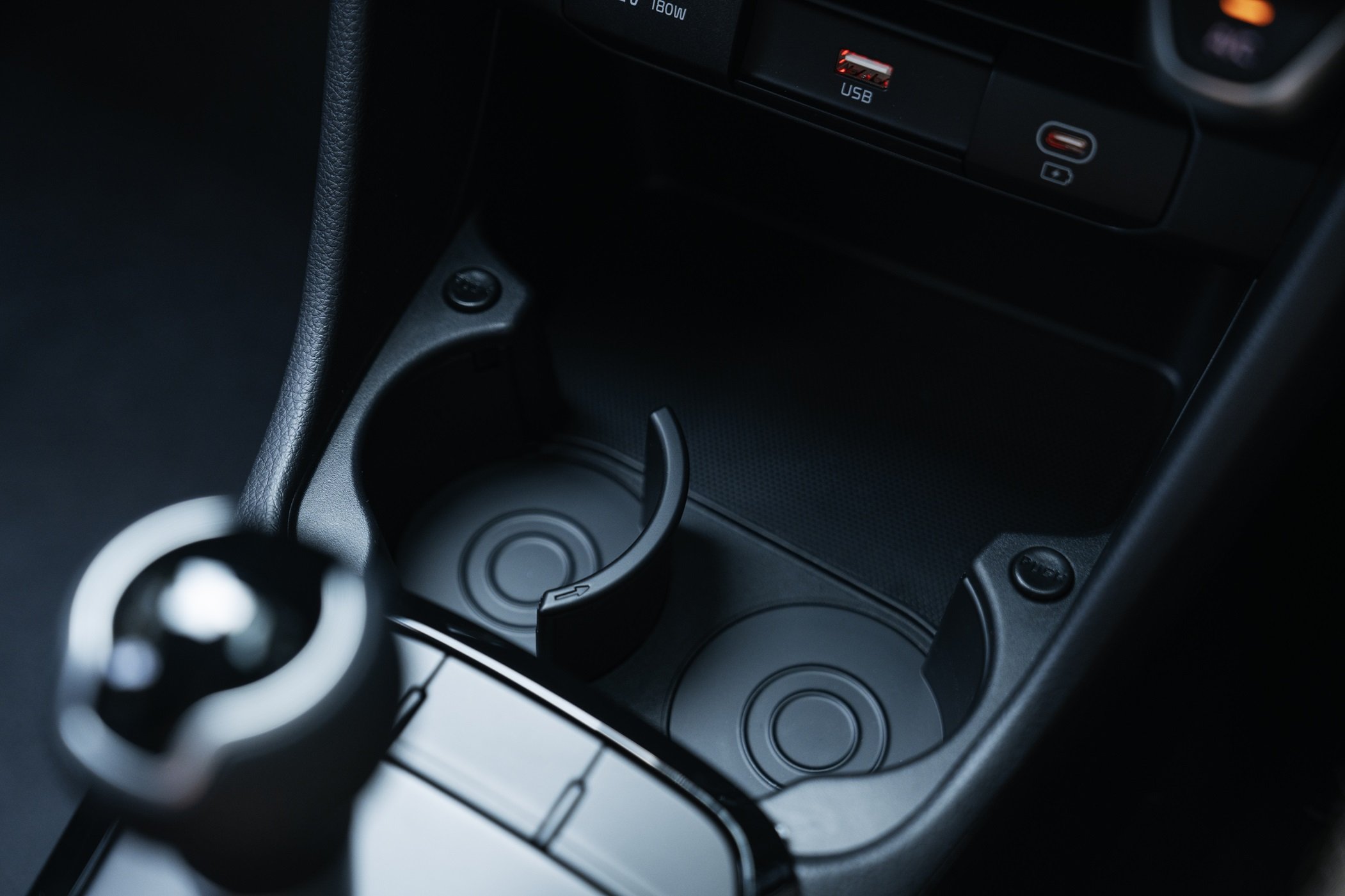
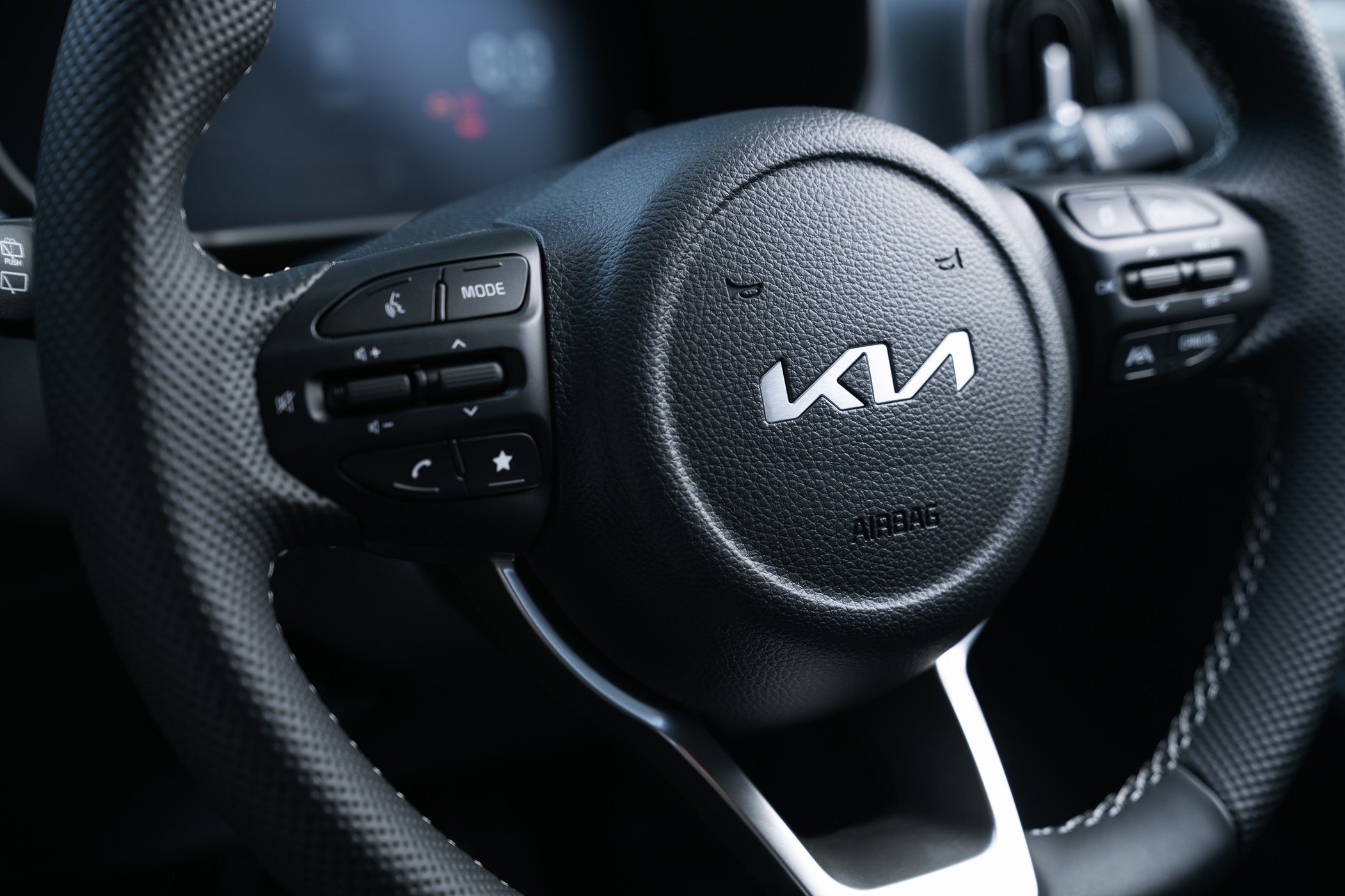
In a Sportage, you have to figure out that there’s a little arrow on the LCD touchpad to cycle between the HVAC controls on the lower section of the dashboard. With a Picanto, you just turn the dial to warm or cold. You rotate the dial between fan positions. You push a button for recirculating the air, rear demister and the AC.
If this is a prospective new car for your leaner-driver teenage son or daughter, this is blissfully safe simplicity that notionally more modern cars lack with their pompous interiors and gigantic tablet touchscreens begging your kids to take their eyes off the road.
The Picanto’s steering wheel is the same. Everything essential to driving the vehicle is there, on the correct side (left for audio/comms, right for primary driving like cruise control).
I'll help you save thousands on a new Kia Picanto here
Just fill in this form.
No more car dealership rip-offs.
Greater transparency.
Less stress.
MAIN COMPETITORS
TOYOTA YARIS (hatch only) | $28,200 - $31,250 (before on-road costs)
The new Yaris is a compelling option in the micro/light car market, and it certainly has a longevity of the nameplate that will draw you in. Right up to the point you see one in person… It is on the ‘interesting’ side of front-end styling. But the good news is you probably won’t notice this unless you have eyes. So that’s nice.
The new Yaris is going to be the platform for the new Mazda 2 when it replaces the current model in the next two years, and that means they will share powertrains. It’s Toyota’s 1.5-litre 3-cylinder petrol engine that makes 88kW, weighing 1075kg in the highest ZR model grade. The transmission is a CVT with 10 gear ratios/speeds (which is a lot), and luggage space is 270 litres.
Yaris also gets a hybrid version which, in ZR trim, claims a combined cycle bench test fuel economy figure of 3.4 litres per 100km. Mind you, the tank is only 36 litres of 91 RON compared with 40 in the combustion-only ZR, but the hybrid weighs an additional 55kg. This means the power-weight ratio goes down on the hybrid to 76 kW per tonne versus 83 on the combustion-only.
So the performance isn’t as good (and therefore the economy drops) once the vehicle gets going from stationary; that’s where the fairly small 0.763 kWh lithim-ion gets the car going before the engine takes over.
It’s hard to see how the Mazda’s interior wouldn’t be nicer to sit in than the Yaris. That’s kind of Mazda’s thing these days. If you do a project with Mazda, they get the nicer interior, and Yaris is no exception. Expect plenty of grey plastics and simplistic, minimalistic styling effort from the Toyota.
MAZDA 2 (hatch or sedan) | $22,870 - $28,070 (before on-road costs)
With a base model ‘Pure’ starting at $26,700 driveaway in manual transmission form, the Mazda 2 is a red-hot value for money proposition and a fantastic first car for learner and probationary drivers - especially those who want to learn to drive a proper gearbox.
The little Mazda might be the bargain basement entry-level Mazda, but that doesn’t mean it’s a stripped-out poverty pack situation, even in the ‘Pure’. It’s actually very well equipped and makes use of every nook and cranny for practical solutions.
In the three-tier model range, the best performance can be had again with the ‘Pure’ in manual transmission where you get an 82kW peak power output but also a 79kW power-weight ratio. In this vehicle and you can use all the kilowatts available (much like driving a sporty MX-5), whereas the auto transmission saps a little bit of power, adds weight, and so too does all the additional equipment in the higher trim levels. So a Pure in auto gets 81kW and is reduced to a 76 kW power-weight ratio - that’s a 3 per cent loss of useabge power just by going for the auto.
If however, performance is not a desire of yours (or your learner driver teenager), then by all means, just select the one that suits your budget and enjoy a minimalist but functional interior that’s actually quite comfortable, nimble, dead-easy to park and has a ridiculously good turning circle of just 9.4 metres. That’s 11 per cent better turning circle than a Mazda 3 and CX-3, which is based on a Mazda 2 anyway, but costs $10,000 more.
SUZUKI SWIFT
Definitely the most over-rated of the four vehicles in discussion here. Cheap plastic interiors are Suzuki’s thing, and you would think that would help to keep the price down, which is kind of does starting at $24,500 for the base model GL. But it really is the base model.
Even the engine you get is a bit gutless with only 66kW on offer and it’s main saving grace there is that the base Swift weighs just 900kg, probably because they’ve spared every expense and it makes the Mazda 2 Pure look like a Bentley. For virtually the same price you get 22 per cent more power in the Mazda 2. And the fuel economy is virtually identical, yet Mazda uses direct injection where Suzuki uses multi-point injection as the means of delivering fuel to the cylinder, meaning the Suzuki is turned for economy, not performance, and when you’ve only got 66kW then add four people on a Friday night, it’s going to be slow.
Headlights (y’know, the ones you use to actually see the road at night) on Swift GL are halogens where they’re LEDs on the Mazda 2 Pure. Suzuki gives you LED daytime running lights and taillights, but not the actual headlights where LEDs would actually help the driver see. You can get LEDs on the higher spec versions, just insert more coins.
Swift does get a satnav, although that’s negated by Apple Carplay and Android Auto anyway, Swift doesn’t get DAB+ digital radio (Mazda 2 does), Swift doesn’t get more than 4 speakers (Mazda 2 gets 6), and nor does the Swift get blindspot detection or rear parking sensors to go with the reversing camera (all of which a Mazda 2 gets). But you can pay an additional $1500 for the Swift GL ‘Plus’ to get this gear - making it more expensive than the Mazda 2 anyway.
The Kia Picanto has all of this equipment on its top-spec GT-Line for $2000 less than both Mazda 2 and the Swift base models.
DRAWBACKS
It goes without saying the Picanto is small. You might also look at it from a glass half-full perspective and say that it is efficient. It is fair to say that being able to carry a bulky thing in the boot with the kids at the same time does have its merits.
It’s also worth noting that this is strictly a front-wheel drive proposition - no all-wheel drive Picanto is available, and obviously that goes with the territory you’re buying in. Yaris, Swift, Picanto, Mazda 2, the VW Polo, they’re all front-wheel drive and this really only matters if you’re taking off from the lights aggressively or simply going too fast into corners in heavy rain. Or doing either of these things on a steep incline.
The thing is front-wheel drive is quite okay at driving in wet conditions, on steep streets and on wet steep streets. All new cars have traction control, electronic stability control and ABS braking systems, so a Picanto is going to be just as good as any on-demand or active AWD system you’d find in more expensive versions of any of these vehicles.
The spare wheel in a Picanto is a space-saver because, erm, the engineers are trying to save space, and in a micro/light car, that’s a perfectly reasonable design brief.
And if you’re expecting lots of clever storage cubby holes and generous door bins for oversize water bottles and elbow-deep centre console stowage options for your designer handbags, then you’re the one with unreasonable expectations here. Big things need to go in the footwells, or on the back seat with a seatbelt clipped in around them to prevent them coming forward during heavy braking.
The boot in a Picanto is surprisingly deep and decently wide, without being vast, so take your essentials, do the family shopping and use cardboard boxes instead of shopping bags which tip over and squash the bread.
And there is the one ergonomics point to make here that climbing down into and up out of a Picanto is not as easy on anybody with mobility issues, compared with a small or medium SUV - and that’s a legitimate reason for a higher vehicle.
But let’s be clear, your preference for an SUV is not about visibility or getting into or out of it, it’s a perception thing. People perceive SUVs as being higher up and therefore offering notionally better vision - which is bullshit.
Simply dropping back from the vehicle in front, you will be able to see just as much or possibly more than in an SUV. This is an excuse for poor, lazy or aggressive driving habits (like tailgating), or simply not paying enough attention to the driving environment.
ENGINE
Without going into technical detail, the engine choice in Picanto is very simple - if a little boring now that Kia Australia is (sadly) dropped the 1-litre turbocharged 3-cylinder engine in the previous model. (That was a hoot to drive, that little turbo-3. Sigh.)
Anywho, you get a 1.2-litre naturally aspirated (non-turbo) petrol 4-cylinder engine making 62 kilowatts, which isn’t terrible, but not as exciting as, say, a turbocharged 1-litre 3-cylinder engine that used to make 74 joyful kilowatts thanks to low-RPM power (172 Newton-metres of torque) available from 1500-4000 RPM. That’s the magic of turbocharging - efficiency.
So Picanto now gets along okay, just not as spritely as it used to. And for most parents wondering (or is that worrying) what time their P-plater kids will be home on a Saturday night as designated driver, 62 kilowatts is plenty. It’s plenty because Picanto is also a featherweight at just 1019kg of kerb weight with a full 35-litre tank of 91 fuel. So a $50 note for fuel is going to go a long way in this little machine thanks to multi-point injection (that’s the economical state of tune for fuel delivery into the cylinder), and with correctly inflated tyres of course.
On 16-inch alloy wheels, Picanto’s rubber will be cheaper to replace in a few years time compared with a larger SUV on bigger rims, and you get a space-saver spare tyre that is speed restricted to 80km/h (for the tyre’s sake; it’s standard fare on all temporary spare tyres). So in the unfortunate event of a puncture, you probably live fairly close to a tyre shop, so have the flat tyre replaced promptly (same day if possible).
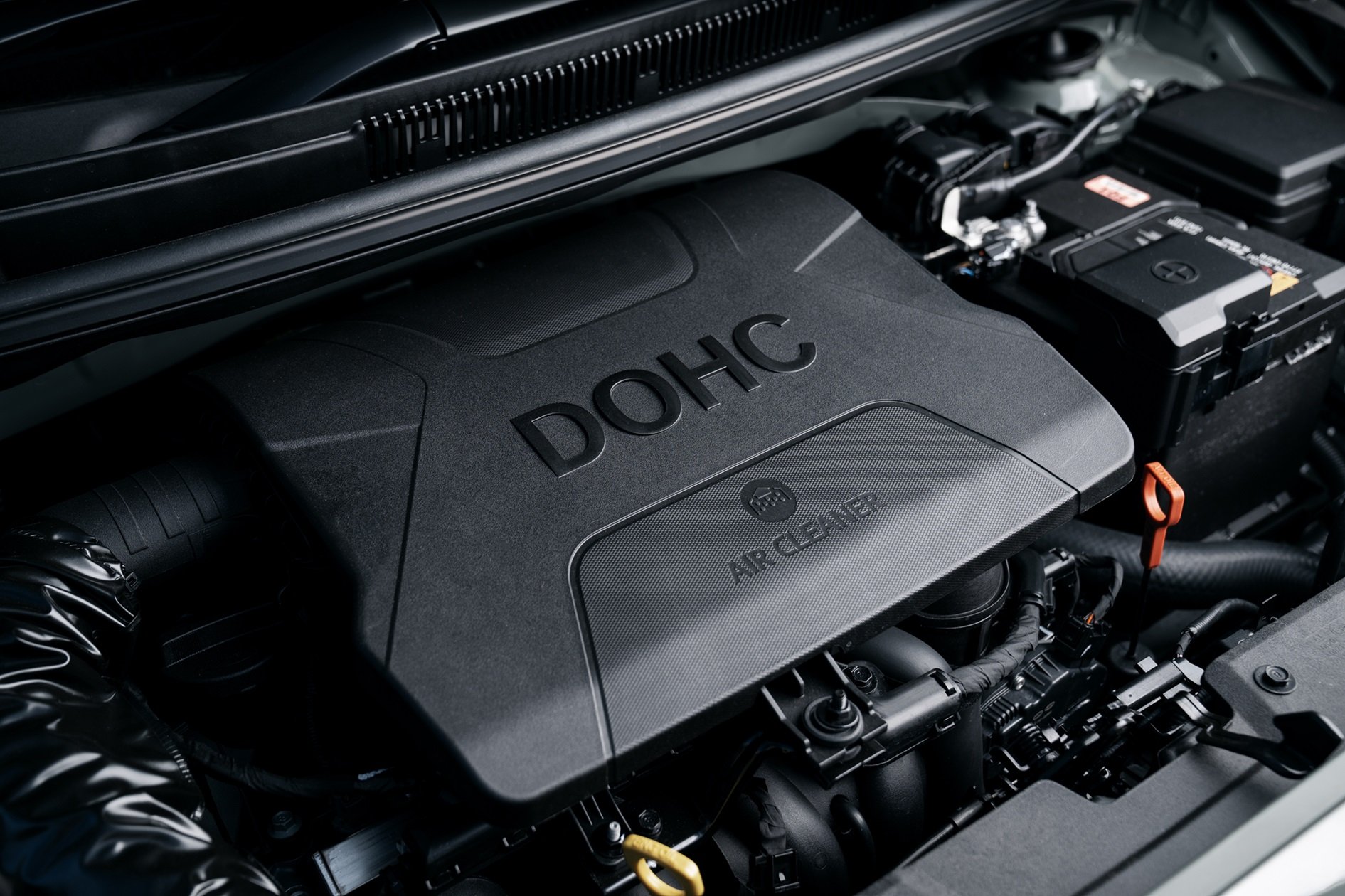

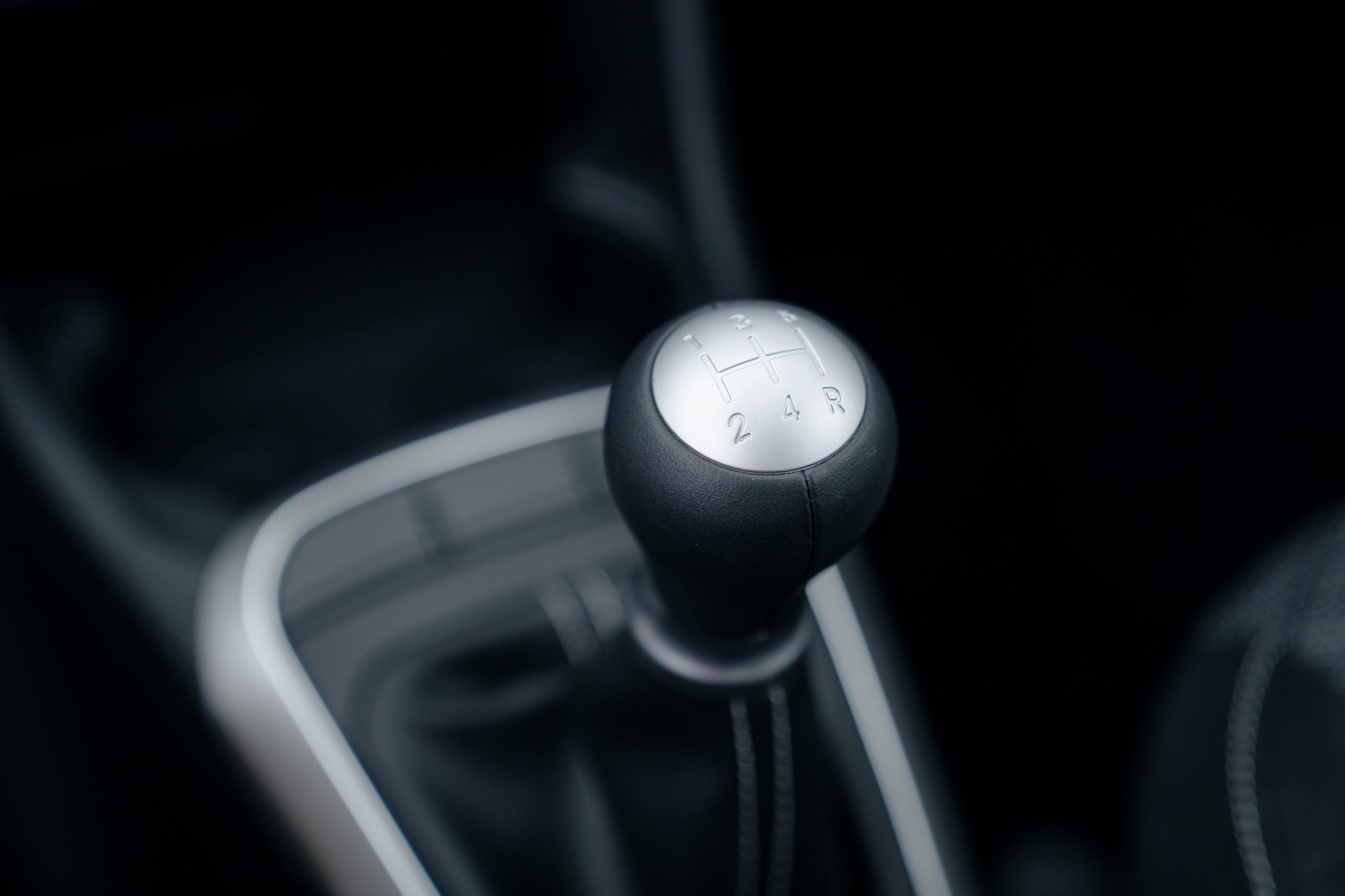
The transmission is either a 5-speed manual in the ‘Sport’ base model or the GT-Line (which is pretty awesome), or a four-speed epicyclic automatic. ‘Epicyclic’ just means the ‘normal’ auto, as opposed to a CVT or dual-clutch, and it’s pretty reliable, shifts nicely enough.
The manual has a nice short friction point on the clutch pedal while the shifter itself also has a positively engaging notch to it, with short throws for the shaft itself. A good gearbox to teach them on with plenty of ‘mechanical robustness’ baked in.
CONCLUSION
If you want to teach your kids to drive, if you need to downsize your fleet at home because of legitimate cost-of-living pressures and/or perhaps you simply want to got back to the way cars used to be: modest, effieient and CHEAP - then the Picanto has your name on it.
The Mazda 2 does come in sedan if you need that bit more boot space, but as an affordable, snazzy and well appointed little runabout for under 30 grand the Kia Picanto is a featherweight that punches very hard against bigger, more expensive and more widely advertised SUVs.
Car companies don’t want you to think about their tiny cars because they want you to spend more and get more vehicle than you actually (probably) will ever need. It’s why you’ll never see ads on the train or bus windows for a Kia Picanto GT-Line manual for $23,500. Because they want you to buy a Sportage for you and your two kids, even though that’s 3 occupants easily conveyed in a 4 adult-seating Picanto.
You just need to lower the back seats to get that big new TV home - or simply pay for a courier in the same way we pay extra for something as trivial as food delivery.
If the financial pressure of the world around you is getting too much, the Picanto is a genuine solution to reduce the number and size of holes in your bucket. We’re all looking for a ‘less is more’ approach to our lives - dieting, exercise, workload, social media, money - then why not do the same with your car?
























The Mitsubishi Outlander is an excellent-value seven-seat family vehicle with plenty of features and capability. It looks modern and tough, but you need to know if it’s going to be good enough compared with other medium SUVs.